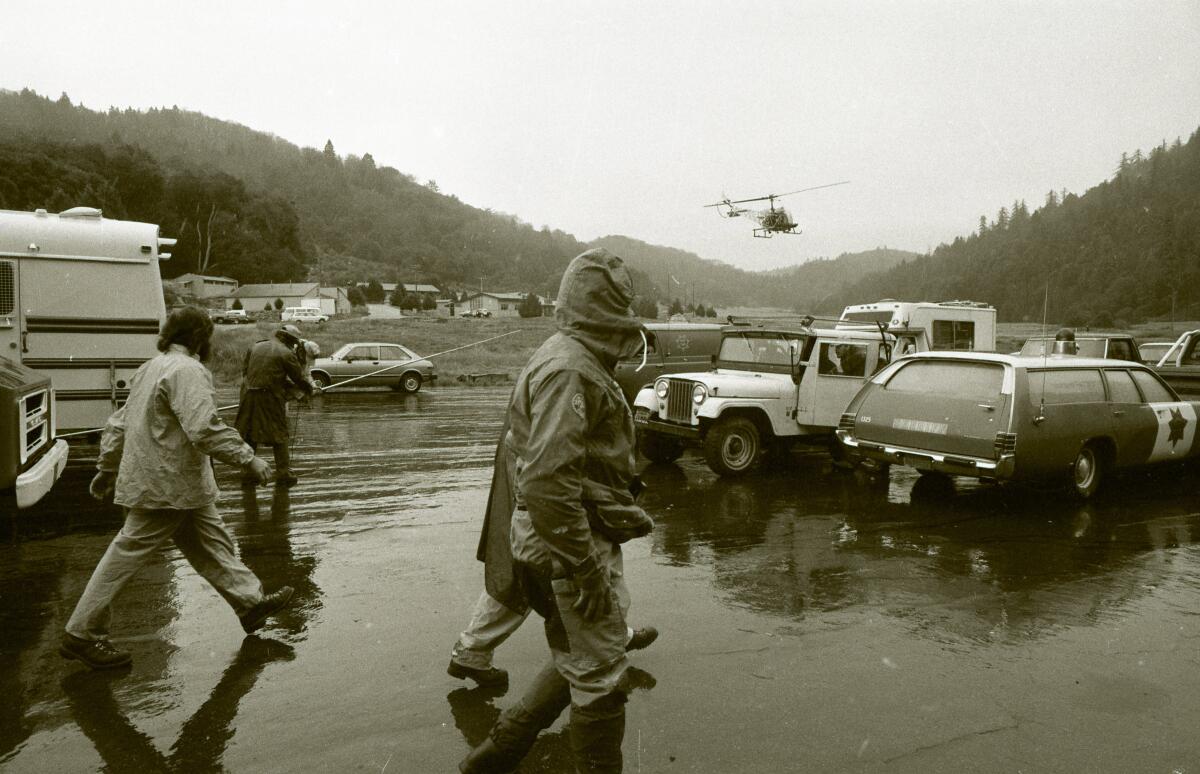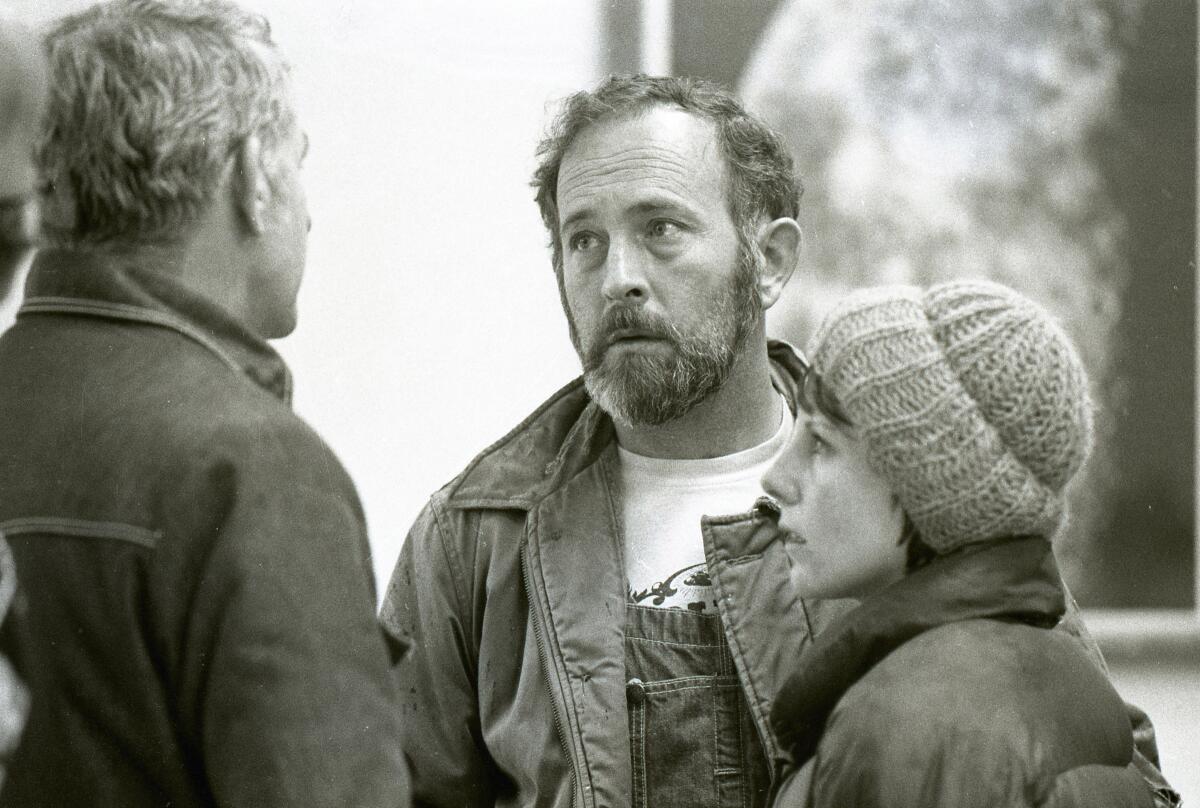Boy’s death on a San Diego County mountain led to wilderness survival program that endures

- Share via
SAN DIEGO — Eli Fordham was lost and terrified.
Just 4 years old, he had set off to find a lake near his family’s campsite and now was alone in the Sierra Nevada wilderness.
Dressed in a swimsuit and T-shirt, he wandered for hours on that September day in 1984.
A search party quickly formed near Chubb Lake in Nevada County. A dog tracked the missing boy’s scent to a cliff, and his father worried that Eli had fallen over the edge as searchers looked for him.
Night came. Then morning.
On the second day, something Eli had heard discussed at his brother’s Cub Scout meeting months earlier in the San Diego County town of Santee popped into his head. The children were told that if they ever became lost in the wilderness, they should do one simple thing: hug a tree.
Instead of wandering around — possibly walking away from those searching for them — lost kids should stay put.
Eli remembered the lesson and stopped walking. He found a tree trunk, sat down and started talking with it. For a really long time.
“In my 4-year-old head, I was having a conversation and it was talking back and it just kept me right there,” he recalled.
Finally, a searcher on horseback rode up. People had been looking for Eli for nearly 24 hours. The boy looked up and asked the man: “Where have you been?”
Eli was found — alive, unharmed — because another San Diego County boy lost in a forest a few years earlier wasn’t found until it was too late.
***
It was 40 years ago this month that the Hug-a-Tree and Survive curriculum was unveiled. The program was launched just weeks after the death of Jimmy Beveridge, a 9-year-old Spring Valley boy who got lost in February 1981 during a trip to Palomar Mountain.
Jimmy had gone on a nature hike with his two brothers, but only his brothers came back, running a foot race to the campsite. Robbie, 16, and Jeffrey, 7, told their parents they thought Jimmy was trailing behind them.
His parents went to look for him, then notified a park ranger.
That afternoon, what would become the largest search in San Diego County history up to that point was launched. Volunteers joined with Marines and law enforcement officers — a group that eventually numbered more than 300, according to some estimates — to scour the state park for any sign of the fifth-grader. For days, searchers tackled terrain on the 5,000-foot mountain, from steep cliffs to rolling meadows, at times crawling through thick manzanita and peering over sheer drops.
They faced difficult weather conditions. Sunny skies turned into heavy rain, thick fog and frigid temperatures, grounding helicopters and washing away tracks the boy might have left behind.
Law enforcement officials gave frequent updates on the search. “Jim is supposed to be a very active boy, a tree climber,” a sheriff’s spokesman told reporters the second day he was missing. “He fancies himself as someone who can take care of himself.”

Jacquie Beveridge said her son was bright, precocious — a child who could speak in full sentences soon after he first started talking and an adventurer who picked up swimming so quickly the instructor called him amazing. Jimmy was learning to play chess and was already a challenging opponent to his stepfather after just two lessons, she said.
The day after Jimmy went missing, a searcher on a helicopter spotted a jacket on the ground, but the find wasn’t immediately pursued as a lead. The boy had been wearing a blue jacket, and this one appeared to be red or orange. Rescuers later realized it was Jimmy’s jacket, turned inside out, with the lining pointing outward. When it was spotted again two days later, searchers shifted their focus to that area.
On the fifth day he was missing, Jimmy’s body was found. He was curled up next to a tree in a ravine in an area the Los Angeles Times described as “almost straight up and down” terrain, clad in a T-shirt and pants and socks. It was Feb. 11 — the wedding anniversary of his mother and stepfather.
The coroner said the boy had apparently fallen and hit his head before dying from hypothermia and exposure, probably on the third day he was missing.
***
Those looking for Jimmy were devastated, and several were determined that no other child would suffer the same fate.
One of them, Steve Scarano, started his own wilderness education effort.
The now-retired Oceanside police captain felt an enormous loss after hearing Jimmy had been found dead. Within months, he arranged for search-and-rescue experts to talk at a school. For the next decade, he helped organize annual wilderness survival seminars in Oceanside and taught on his own as well.
“It felt like there needed to be something done,” he said.
Scarano said he could imagine Jimmy lost in the forest: “I could see a kid panicking and running blindly and totally terrified.”
Another message he stressed to children was not to give up if they become lost. “The friendly strangers are going to find you, don’t give up,” he said. “Wait for them faithfully and just don’t give up the spirit. Choose to live.”
Jimmy’s death prompted freelance photographer Tom Jacobs and Albert “Ab” Taylor, a renowned tracker with the Border Patrol, to work with others to develop the Hug-a-Tree program. They, too, had participated in the fruitless search for Jimmy.
Ab Taylor dies at 88; famed tracker who worked to help children
The principles are simple: If you get lost, stay put — hug a tree — until help arrives. Children were told to bring along a whistle so they could alert searchers and a trash bag that could be used as a makeshift shelter. If they were near a clearing, they were told to make a cross or S-O-S out of brush or rocks to get the attention of helicopters or planes that might be searching.
Parents were told to use foil to get imprints of their kids’ footprints so tracking would be easier.

Within a month of Jimmy’s death, the program was being taught to schoolchildren. It was shared in hundreds of classrooms in San Diego County and later expanded to other states, spurred in part by a story in Women’s Day magazine.
It has since been translated into several languages and expanded into Canada and Mexico, said Christopher Boyle, executive director of the National Assn. for Search and Rescue, which distributes the program. “We are trying to expand it out,” he said. “We are happy it is in three languages right now.”
Although technology has changed, the curriculum’s heart remains the same: Slideshows and cassette tapes gave way to video, and the foil trick was replaced by recommending that parents snap a cellphone photo of shoe soles. The program can be downloaded for free.
“We talk about how important it is if you’re lost just to sit down and stay put. It is not going to be very long and we are going to come looking for you. And if you stay put, you’ll be a lot closer than if you walk in the wrong direction.”
— Eli Fordham
No statistics are kept on how many children have been found thanks to the program, but Boyle feels it is the most effective one for keeping them safe in the outdoors.
Scarano said he finds the program “just saturated with hope” and that it offers a sound educational message. The hug-a-tree message has been around so long, he said, that is has become “a household word, at least in the outdoor industry.”
The fact that the effort has endured means that Jimmy’s death didn’t happen without bringing about some good, his mother said.
“Even today, we know of people being found because they knew what to do,” Beveridge said. “It is so heartwarming to know that 40 years later, it is still working and making a difference.”
***
These days, Eli Fordham lives in Utah. The father of three children says he “can’t even imagine 24 hours with a 4-year-old out in the wilderness overnight.”
Said his mother, Patsy Fordham: “Twenty-two and a half hours, but who’s counting.”
When Eli took off for the lake that day, she and her husband saw him go and were walking behind. Patsy looked down to keep herself from tripping on a rock just as he came to a fork in the trail. When she looked up, he was gone.
“Where he disappeared, there were five different trails. I took one, his dad took one and he took one of the other three,” she said.
Patsy Fordham had heard the Hug-a-Tree lessons outlined during that Cub Scout meeting she and her boys attended. But she didn’t equip Eli with a whistle or a plastic bag or take imprints of his shoes during their camping trip.
“I felt stupid when we lost him. I had heard about this program, I watched the whole thing,” she said. “I felt like I should have been a much better mother and followed those things.”
Fordham felt so strongly about the program after Eli’s experience that she went on to teach it for more than 15 years with the U.S. Forest Service in Utah. Thousands heard her talks at an annual natural resources festival, she said.
“Often I think why did that happen to us? But then I think I’ve been able to teach so many more people about this.... That was the reason maybe it happened,” she said. “It was for me to share that and hopefully save a few lives.”
For his part, Eli Fordham still tries to heed the program’s basic safety messages when he’s camping or hiking with family and friends.
He knows that he was found because Jimmy wasn’t.
“We talk about how important it is if you’re lost just to sit down and stay put,” he said. “It is not going to be very long and we are going to come looking for you. And if you stay put, you’ll be a lot closer than if you walk in the wrong direction.”
Kucher writes for the San Diego Union-Tribune.
More to Read
Sign up for Essential California
The most important California stories and recommendations in your inbox every morning.
You may occasionally receive promotional content from the Los Angeles Times.














